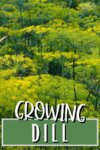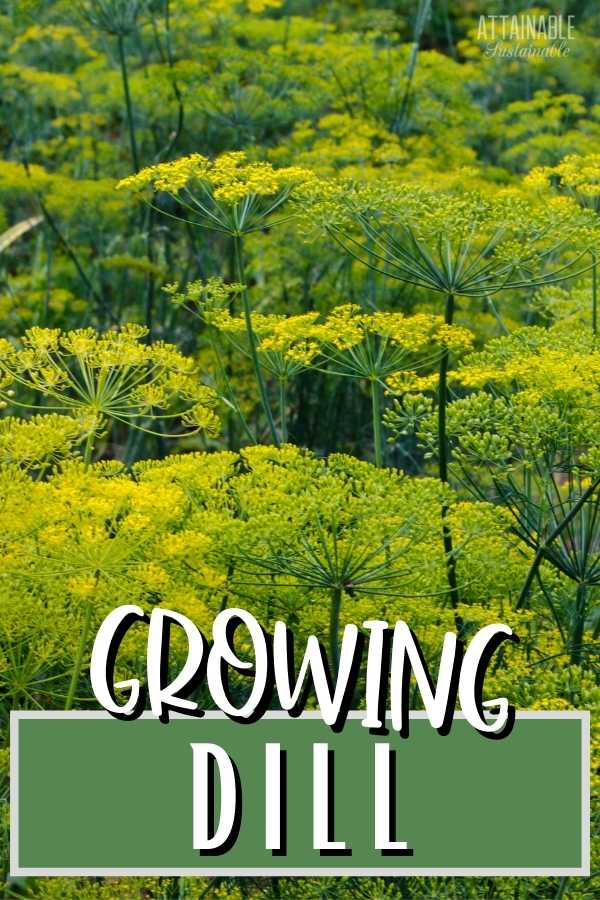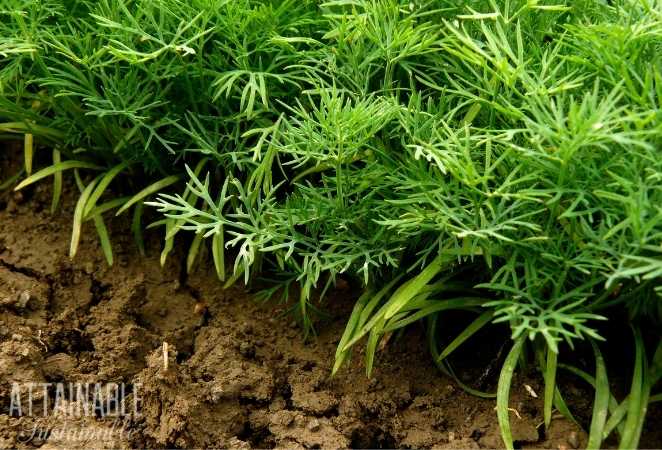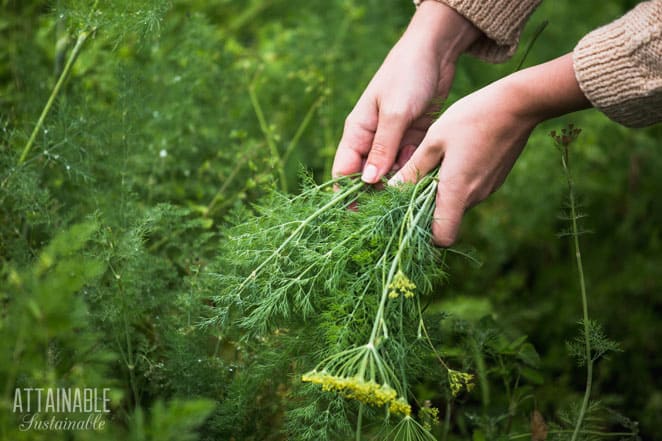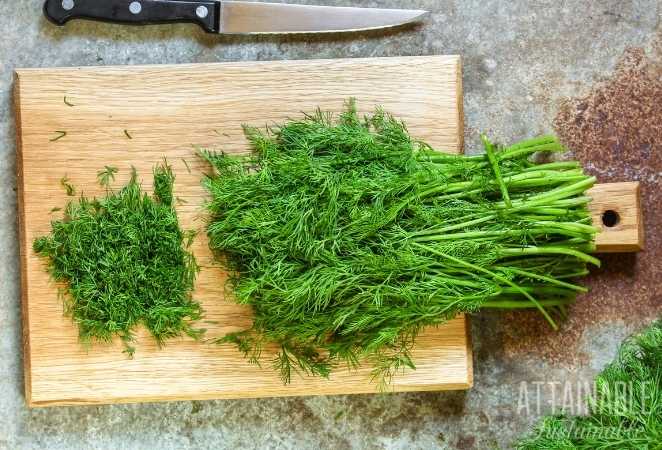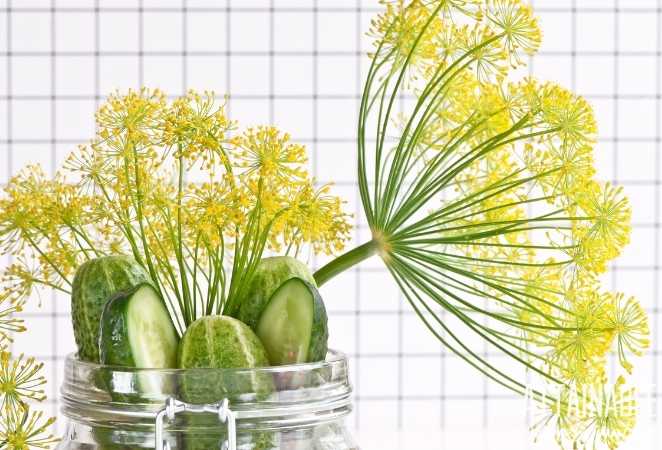Dill is an herb that serves multiple purposes in the garden. It’s an attractive plant in either the herb or flower garden, it grows fine, feathery-like foliage that’s used as a delicious flavoring and it also produces large, ornamental umbrella-like flower heads that produce dill seeds. Seeds can spread themselves and sprout to grow the next season when conditions are right.
Chives are another great herb to grow in your home garden.
Contributed by Jodi Torpey, author and Master Gardener.

All about dill
In addition to its many uses in the kitchen, dill plants attract butterflies and other pollinators to the garden. Dill is a host plant to adult female butterflies, like black and anise swallowtails. Butterflies lay eggs on the dill to feed their caterpillars. Plant plenty of dill to make sure there’s enough for gardeners and butterflies alike.
Dill is an adaptable and fast-growing tender annual plant that can reach 3 or more feet tall with an airy, upright habit. Dill (Anethum graveloens) can be planted in spring for a summer crop. Unlike many other herbs, dill can tolerate slightly dry soil conditions.
Known for its culinary, cut flower and medicinal uses, all parts of the dill plant are aromatic, from its leaves to seeds and flowers. The flowers are fragrant as cut flowers and can also be dried.
Grow Some Greens!
Ready to grow fresh greens, no matter WHERE you live? Sign up for my
FREE quick-start guide and start growing some of your own food!
Dill is easy to grow from seed and can be started from seeds indoors or directly sown in the garden. Start seeds indoors early in spring and allow about 2 weeks for seeds to germinate. Wait for plants to be several inches tall before hardening off and planting.
To direct sow, plant seeds about ¼ inch deep and 1-2 inches apart. If planting several rows, make sure to leave 6-8 inches between rows.
Dill transplants are also available at garden centers. Be sure to give plants time to become acclimated to outside conditions before planting. Keep soil moist until plants become established.
Dill needs room to grow, at least 12 inches between plants. Be sure to thin crowded plants so foliage will be thick and lush.
If you want to ensure fresh dill leaves through the season, continue to sow seeds every 3-4 weeks from spring into fall using a succession planting method. Plants will start to decline after flowering, another reason to keep up with successive plantings.
New to gardening? Limited on space? The 5-Gallon Garden gives you the skills you need to grow food in the space you have. Get started with your garden today!
Dill types
There are several popular varieties of dill to choose from. Look for the kind that best matches your favorite uses.
Hera is a dill variety known for its masses of blue-green leaves and a long season of growth before it starts to flower and goes to seed.
Fernleaf is a dwarf dill that does well in small spaces and containers; grows to less than 2 feet tall and stays compact.
Long Island Mammoth is an especially vigorous variety of dill that matures quickly to a height of about 36 inches. Large flowers produce a mammoth amount of dill seeds.
Dukat is another dill variety that is slow to go to seed. Foliage forms and stays on plants before the plants form exceptionally large seed heads.
Requirements for growing dill
Light requirements
Locate a sunny spot in the herb, vegetable, or ornamental garden. Dill prefers full sun to grow to its full potential, but it can also grow under partial sun conditions. One of dill’s benefits is that it can look fresh even in high summer temperatures.
When selecting a site for planting, consider how tall dill plants will grow. Because of their size, these plants make a good middle or back border for vegetable, ornamental, annual beds or culinary herb gardens.
Soil requirements
Amend the soil to a well-draining, moderately fertile soil. However, as many gardeners will agree, dill seeds can sprout just about anywhere and will grow in less than perfect conditions.
Water and fertilizer requirements
Dill plants grow best when the soil stays moderately moist. Plan on regular deep watering by setting up drip irrigation or a soaker hose. Another alternative is to plant dill near other herbs that have similar sun and water needs.
As with most herbs, a little fertilizer throughout the season helps plants stay healthy and productive.
Dealing with dill problems
Dill is one of the herbs that has few, if any problems, in the garden. Insect pests don’t seem to be attracted to the frilly leaves and there aren’t any disease issues.
Plants grown in shady conditions may have a tendency to lean, but staking them will prevent this problem.
Growing dill in pots
Dill makes a nice plant for large patio containers. Be sure to use a high-quality potting soil mix that allows for good drainage. The compact, dwarf dill varieties are perfect for containers and raised beds. Other taller types may outgrow their space.
How to harvest dill
Clip and use fresh dill leaves when plants are about 10 inches tall. Store fresh dill leaves in a plastic bag in the refrigerator. To freeze and save for later, chop finely and mix with water and fill ice cube trays.
Dry dill leaves, often called dill weed, by snipping stalks and drying them on a screen or hanging them upside down in a warm, well-ventilated place to dry. Store dried leaves and seeds in an airtight container in a cool, dark place.
Harvest dill heads for making pickles when the
Leave a few plants standing to self-seed in the garden for next season.
How to use dill in the kitchen
Dill is one of those versatile herbs you can use fresh or dried leaves and the seeds either whole or ground. Dill is one of the most popular herbs for all of its culinary uses, especially for making dill pickles.
Use dill’s fresh ferny fronds in dips, dressings, vinegars, sauces and cold soups; chicken, turkey, tuna, fish or other seafood dishes; omelets and other egg recipes; mix into cottage cheese, sour cream and mild cheeses; and tangy potato salads. A few favorite recipes are Fermented Deli-Style Garlic Dill Pickles, Dilly Beans and Savory Lemon and Dill Pizzelle Crackers.
When cooking with fresh dill leaves, add them just before serving because they tend to lose flavor when cooked. Dried leaves aren’t as flavorful as fresh, so sprinkle them into recipes generously.
Dill seeds are more strongly flavored than the leaves and make a delicious addition to cakes and savory breads; braised cabbage, meat stews, rice and cooked root vegetables.
Fresh dill pairs well with other garden-grown vegetables, like these:
How to propagate dill
If you let plants go to seed in the garden, those that fall to the ground may self-seed for the next season. But you can plan to save these seeds instead.
At the end of the season when seed heads start to form, harvest the plant and dry with a paper bag over the seed heads to collect the seeds as they fall from the flowers.
